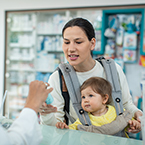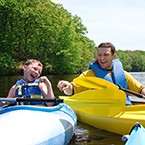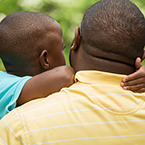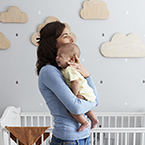Spring 2020
Nutrition Facts Labels Get Helpful Updates
 For all of us who are interested in healthier eating, there’s a lot to like about the updated Nutrition Facts panels on food labels. The U.S. Food and Drug Administration is requiring more complete information that’s easier to understand, and thus more helpful when it comes to making informed choices. The new labels debuted in January 2020 on many foods, and all packaged foods will have them by the summer of 2021.
For all of us who are interested in healthier eating, there’s a lot to like about the updated Nutrition Facts panels on food labels. The U.S. Food and Drug Administration is requiring more complete information that’s easier to understand, and thus more helpful when it comes to making informed choices. The new labels debuted in January 2020 on many foods, and all packaged foods will have them by the summer of 2021.
So, what’s new? Here are some of the bigger changes you’ll find on the new labels.
The ‘Serving Size’ information is bigger and bolder, and it takes into account how people really eat. For packages that contain more than one serving — but whose contents are commonly eaten entirely by one person in one sitting — the new labels show nutrition information two ways: for one serving and also for the entire package. That’s especially helpful for tempting, not-so-healthy items like a bag of chips, a small multipack of cookies or a pint of ice cream. Seeing this information can help us make smarter choices about how much we choose to eat or serve to others.
Also getting a bigger and bolder treatment on the revamped labels is the ‘Calories Per Serving’ information. This information can help you balance the number of calories you or your child eat or drink with the number of calories your body uses. (Of course, not all calories are the same! A hard-boiled egg, 10 almonds or nine potato chips contain roughly the same number of calories, but the first two are far healthier choices.)
And speaking of healthier choices, with so many people cutting back on sugar, here’s another helpful label change. In addition to showing how much sugar the food contains naturally, a new, separate line reveals how much extra sugar the food maker has added. This is especially helpful for foods like canned soups, pasta sauce, protein bars and breakfast cereals that can be ‘hiding’ a surprising amount of sugar.
Since kids enjoy guessing games and decoding puzzles, how about letting them test their skills? Have them measure out a single serving of a few different foods, guess the calories, and then figure out which foods deliver the most protein, carbs, dietary fiber, sodium and sugar. They’ll quickly discover how nutrition labels can help us make smart choices!
Get tips to teach your child about nutrition and making food choices.
Medicine Safety Basics
 Medicines can do all sorts of great things — in the right hands. But used the wrong way or by the wrong person, they can be a dangerous poison.
Medicines can do all sorts of great things — in the right hands. But used the wrong way or by the wrong person, they can be a dangerous poison.
Be sure to store them high enough so that they’re always out of sight and out of reach of young children. Don’t leave bags and purses that contain vitamins or medicines out in the open. Consider a medicine lock box as a simple and secure solution.
And when you don’t need a medicine anymore, dispose of it safely.
Save the Poison Help number in your phone and the phones of your child’s caregivers: 800-222-1222. Call right away if you suspect your child may have ingested something harmful.
Learn more about safe medicine storage.
How Booster Seats Prevent Injuries
 Washington’s new car-seat laws are now in effect. After a child outgrows their harness-style car seat, they must use a booster seat until they reach 4 feet 9 inches tall, which is when a vehicle’s seat belt should fit correctly. Until then, booster seats correctly position the vehicle’s lap belt low across the hip bones, and the shoulder belt across the center of the shoulder.
Washington’s new car-seat laws are now in effect. After a child outgrows their harness-style car seat, they must use a booster seat until they reach 4 feet 9 inches tall, which is when a vehicle’s seat belt should fit correctly. Until then, booster seats correctly position the vehicle’s lap belt low across the hip bones, and the shoulder belt across the center of the shoulder.
In a collision, poorly fitting seat belts can cause injuries to the head, neck, spine and internal organs. Because kids’ bodies are still forming, they’re at a greater risk of injury when compared to adults of the same height. For example, a child’s head is much larger in proportion to the rest of the body, which means a greater chance of spinal-cord injury. And a child’s growing skeleton is made of cartilage, which doesn’t protect internal organs the way adult bones do.
Many kids will need a booster seat until age 10 to 12 — and before they can safely give it up, they must pass a 5-step test when seated in your vehicle.
Learn more about child safety seat guidelines.
Life Jackets for Children and Teens
 For kids of all ages, drowning is a leading cause of unintentional injury-related death. And for every child who dies from drowning, even more receive emergency care for injuries related to being underwater.
For kids of all ages, drowning is a leading cause of unintentional injury-related death. And for every child who dies from drowning, even more receive emergency care for injuries related to being underwater.
Life jackets are crucially important in preventing drownings. They must be U.S. Coast-Guard approved (check the label inside) and they must fit properly. Be sure your child’s life jacket is rated for their weight, and that its straps and buckles are adjusted to provide a snug fit.
When needed, loaner jackets are great as long as they’re in good condition and they fit well.
Wearing a life jacket is an important way to stay safe near and in the water. All children and teens should wear a life jacket any time they are on a boat, raft or inner tube — or are swimming in open water like lakes, rivers or the ocean. Children ages 6 to 11 should also wear a life jacket while on docks and riverbanks; children from birth to 5 years old should wear a life jacket whenever they are in or near water.
Keep in mind that many kids (and adults) who drown never even intended to get wet: they fell in the water.
Life jackets are classified as personal flotation devices (PFDs) and are designed to be lifesaving devices. Water wings, flotation belts and kickboards are instructional flotation devices (IFDs) and are not lifesaving devices. IFDs are sometimes used when learning how to swim and should only be used with direct, hands-on adult supervision — with the adult in the water and within touch-distance of the child. Likewise, floating toys like inflatables and foam noodles are fun, but they are not lifesaving devices.
Learn more about life jackets and drowning prevention.
Validating a Child’s Feelings
 It can be tough for kids to work through their feelings, and there’s a lot parents can do to help. The simple act of recognizing emotions goes a long way. For example, “I understand that you’re mad that it’s time to leave the playground.” Other useful phrases for kids of all ages include: “I hear you.” “Tell me more.” “I see that you’re frustrated.” “How can I help?”
It can be tough for kids to work through their feelings, and there’s a lot parents can do to help. The simple act of recognizing emotions goes a long way. For example, “I understand that you’re mad that it’s time to leave the playground.” Other useful phrases for kids of all ages include: “I hear you.” “Tell me more.” “I see that you’re frustrated.” “How can I help?”
Keep in mind that validating feelings isn’t the same as agreeing with them; we don’t have to be on the same page as our child to hear them out. And role-modeling is important: if we listen and show respect, it’s more likely that our kids will mirror that behavior. Whether they’re toddlers or teens, they want to be heard, understood and accepted — just like we do!
Learn about a parenting tool called emotion coaching.
Never Shake a Baby
 It’s common for babies to cry a lot in their first 5 months. Even healthy babies may cry up to 5 hours a day. Though challenging, it will get better. Usually, crying peaks around 2 to 4 months.
It’s common for babies to cry a lot in their first 5 months. Even healthy babies may cry up to 5 hours a day. Though challenging, it will get better. Usually, crying peaks around 2 to 4 months.
Always handle your baby gently. Increased crying is the number-one reason why people shake babies. Violent shaking (even for a few seconds) can cause severe and permanent injuries — and even death.
Tell your child’s caregivers these important things: 1) Lots of crying during the first 5 months is normal, and so is feeling frustrated. 2) To call you if the crying becomes difficult to handle. 3) It’s OK to put the baby down in a safe spot and take a break nearby. And remember: if you’re feeling overwhelmed yourself, reach out for help.
Learn about The Period of Purple Crying.
Trampoline Safety
 Trampoline parks have become popular spots to celebrate a child’s birthday or burn energy on a rainy day. With this increased popularity, trampoline injuries are on the rise.
Trampoline parks have become popular spots to celebrate a child’s birthday or burn energy on a rainy day. With this increased popularity, trampoline injuries are on the rise.
Accidents can occur in a number of different ways: failed stunts, colliding with another jumper, landing wrong or falling off. Common injuries include bruises, strains, broken bones and concussions.
While injuries can happen in trampoline parks or jump gyms, they’re even more common on home trampolines. In fact, the American Academy of Pediatrics recommends not having a home trampoline. However, if you’re OK with the risks involved — whether at home or at a park — the American Academy of Pediatrics has some helpful safety tips.
Quick Tip
More daylight allows time for more fun, but try to stick to bedtime routines and schedules. Sleep helps growing bodies and minds.